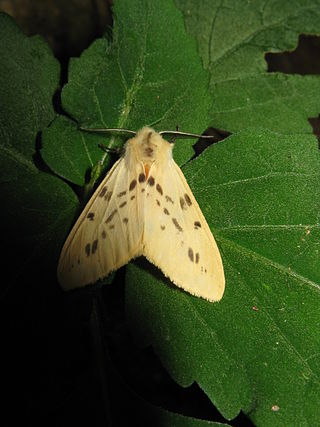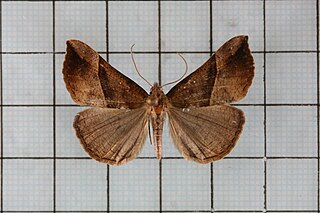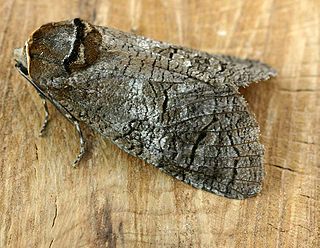
The vampire squid is a small cephalopod found throughout temperate and tropical oceans in extreme deep sea conditions. The vampire squid uses its bioluminescent organs and its unique oxygen metabolism to thrive in the parts of the ocean with the lowest concentrations of oxygen. It has two long retractile filaments, located between the first two pairs of arms on its dorsal side, which distinguish it from both octopuses and squids, and places it in its own order, Vampyromorphida, although its closest relatives are octopods. As a phylogenetic relict, it is the only known surviving member of its order.

The Charaxinae, the leafwings, are a nymphalid subfamily of butterflies that includes about 400 species, inhabiting mainly the tropics, although some species extend into temperate regions in North America, Europe, China, and southern Australia. Significant variations exist between the species. For example, some are medium sized and bright orange above, but mottled gray or brown below. This underwing coloration helps them resemble a dead leaf when they are at rest, as they keep their wings closed. With relatively few exceptions, the hindwings of the members of this subfamily have jagged edges.

Delias is a genus of butterflies. There are about 250 species of the genus Delias, found in South Asia and Australia. The genus is considered to have its evolutionary origins in the Australian region.
The blind swamp eel is a species of fish in the family Synbranchidae. It is endemic to Mexico where it lives in cave systems and is known in Spanish as the anguila ciega. The International Union for Conservation of Nature has rated this cavefish as "endangered".

Lemyra is a genus of tiger moths in the family Erebidae. The genus contains many species from East and South Asia, Sundaland and Australia. It was described by Francis Walker in 1856.

Macrobrochis is a genus of moths in the subfamily Arctiinae first described by Gottlieb August Wilhelm Herrich-Schäffer in 1855.
Walter Karl Johann Roepke was a German entomologist who specialised in Lepidoptera and Coleoptera.
Eubryopterella is a genus of moths of the family Erebidae. The genus was described by Roepke in 1938.

Hypospila is a genus of moths in the family Erebidae. The genus was erected by Achille Guenée in 1852.
Tamsia is a monotypic moth genus in the family Erebidae described by Roepke in 1938. Its only species, Tamsia hieroglyphica, was first described by Swinhoe in 1902. It is found on the Indonesian island of Sulawesi.

Sataspes is a genus of moths in the family Sphingidae erected by Frederic Moore in 1858. They are mimics of carpenter bees.

Macrobrochis borneensis is a moth of the family Erebidae. It was described by Walter Karl Johann Roepke in 1939. It is found on Borneo and Peninsular Malaysia, and possibly Java and the Philippines.

Macrobrochis gigas is a moth of the family Erebidae. It was described by Francis Walker in 1854. It is found in China (Yunnan), India (Sikkim), Bhutan, Nepal, Indonesia, Hong Kong and Taiwan. The habitat consists of woodlands.
Spilarctia ananda is a moth in the family Erebidae. It was described by Walter Karl Johann Roepke in 1938. It is found on Java and possibly Malacca.

Cossus is a genus of moths in the family Cossidae described by Johan Christian Fabricius in 1793.

The Lithosiina are a subtribe of lichen moths in the family Erebidae. The taxon was erected by Gustaf Johan Billberg in 1820.
Hypospila brunnescens is a species of moth in the family Erebidae. It is found in Indonesia.

Vespula infernalis is an obligate parasitic wasp, parasitizing the nests of other species in the genus Vespula. Its common host species is V. acadica in North America. It is sometimes called the cuckoo yellowjacket wasp due to its inquiline lifestyle. They differ from other parasitic wasps in their intensely aggressive behaviour during invasion and occupation of the host colony. Several morphological adaptations such as bigger body parts and highly curved stingers are present in these wasps to aid their aggressive parasitic behaviour.

John Peter Roepke was an American football halfback who played one season in the National Football League (NFL) for the Frankford Yellow Jackets as well as four seasons in minor leagues with the Atlantic City Tornadoes, Clifton Heights Orange & Black, Upper Darby Greenbacks, and Paterson Night Hawks. A native of New Jersey, he attended Penn State University, playing football, baseball, and basketball before graduating in 1928. He was selected to the College Football All-America Team following his senior season of 1927. Roepke also briefly played professional baseball for the Scranton Miners in 1928.
Pampatemnus is an extinct genus of notoungulate belonging to the family Isotemnidae that lived during the Early to Middle Eocene of what is now Argentina.











